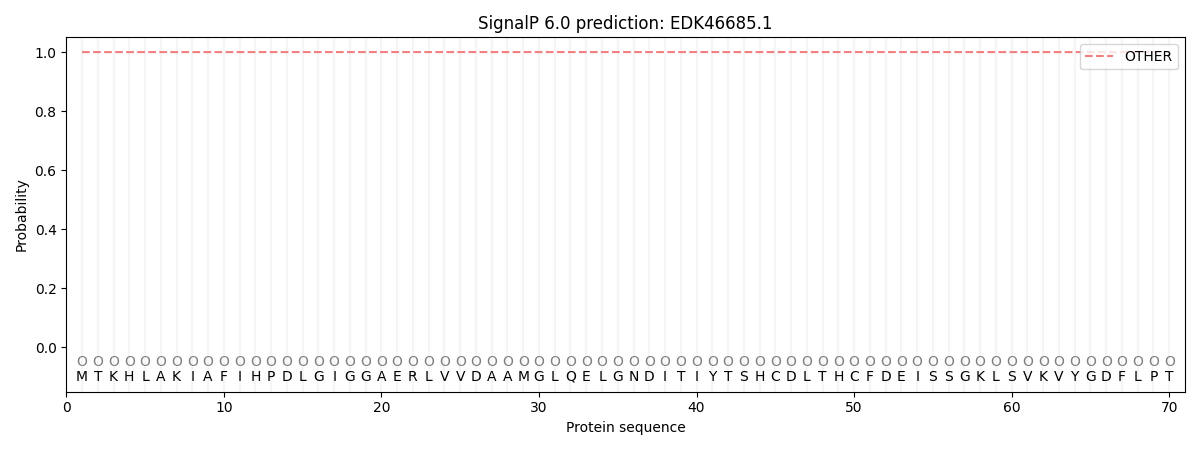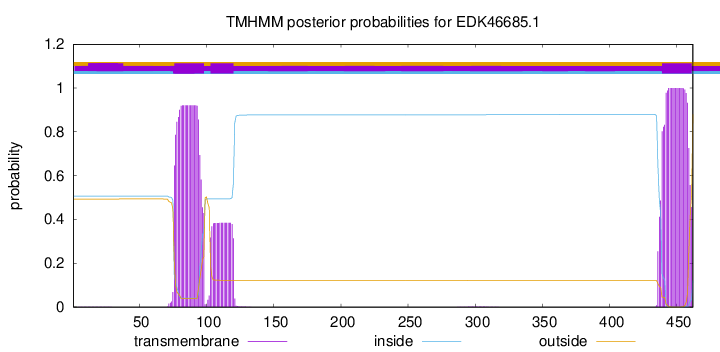You are browsing environment: FUNGIDB
CAZyme Information: EDK46685.1
You are here: Home > Sequence: EDK46685.1
Basic Information |
Genomic context |
Full Sequence |
Enzyme annotations |
CAZy signature domains |
CDD domains |
CAZyme hits |
PDB hits |
Swiss-Prot hits |
SignalP and Lipop annotations |
TMHMM annotations
Basic Information help
| Species | Lodderomyces elongisporus | |||||||||||
|---|---|---|---|---|---|---|---|---|---|---|---|---|
| Lineage | Ascomycota; Saccharomycetes; ; Debaryomycetaceae; Lodderomyces; Lodderomyces elongisporus | |||||||||||
| CAZyme ID | EDK46685.1 | |||||||||||
| CAZy Family | GT62 | |||||||||||
| CAZyme Description | alpha-1,3-mannosyltransferase ALG2 | |||||||||||
| CAZyme Property |
|
|||||||||||
| Genome Property |
|
|||||||||||
| Gene Location | ||||||||||||
Enzyme Prediction help
| EC | 2.4.1.257:6 | 2.4.1.132:6 |
|---|
CDD Domains download full data without filtering help
| Cdd ID | Domain | E-Value | qStart | qEnd | sStart | sEnd | Domain Description |
|---|---|---|---|---|---|---|---|
| 340834 | GT4_ALG2-like | 0.0 | 7 | 425 | 2 | 392 | alpha-1,3/1,6-mannosyltransferase ALG2 and similar proteins. This family is most closely related to the GT4 family of glycosyltransferases. ALG2, a 1,3-mannosyltransferase, in yeast catalyzes the mannosylation of Man(2)GlcNAc(2)-dolichol diphosphate and Man(1)GlcNAc(2)-dolichol diphosphate to form Man(3)GlcNAc(2)-dolichol diphosphate. A deficiency of this enzyme causes an abnormal accumulation of Man1GlcNAc2-PP-dolichol and Man2GlcNAc2-PP-dolichol, which is associated with a type of congenital disorders of glycosylation (CDG), designated CDG-Ii, in humans. |
| 340831 | GT4_PimA-like | 3.33e-30 | 7 | 426 | 1 | 366 | phosphatidyl-myo-inositol mannosyltransferase. This family is most closely related to the GT4 family of glycosyltransferases and named after PimA in Propionibacterium freudenreichii, which is involved in the biosynthesis of phosphatidyl-myo-inositol mannosides (PIM) which are early precursors in the biosynthesis of lipomannans (LM) and lipoarabinomannans (LAM), and catalyzes the addition of a mannosyl residue from GDP-D-mannose (GDP-Man) to the position 2 of the carrier lipid phosphatidyl-myo-inositol (PI) to generate a phosphatidyl-myo-inositol bearing an alpha-1,2-linked mannose residue (PIM1). Glycosyltransferases catalyze the transfer of sugar moieties from activated donor molecules to specific acceptor molecules, forming glycosidic bonds. The acceptor molecule can be a lipid, a protein, a heterocyclic compound, or another carbohydrate residue. This group of glycosyltransferases is most closely related to the previously defined glycosyltransferase family 1 (GT1). The members of this family may transfer UDP, ADP, GDP, or CMP linked sugars. The diverse enzymatic activities among members of this family reflect a wide range of biological functions. The protein structure available for this family has the GTB topology, one of the two protein topologies observed for nucleotide-sugar-dependent glycosyltransferases. GTB proteins have distinct N- and C- terminal domains each containing a typical Rossmann fold. The two domains have high structural homology despite minimal sequence homology. The large cleft that separates the two domains includes the catalytic center and permits a high degree of flexibility. The members of this family are found mainly in certain bacteria and archaea. |
| 223515 | RfaB | 1.02e-25 | 6 | 426 | 3 | 375 | Glycosyltransferase involved in cell wall bisynthesis [Cell wall/membrane/envelope biogenesis]. |
| 340839 | GT4_GT28_WabH-like | 2.03e-23 | 7 | 417 | 1 | 350 | family 4 and family 28 glycosyltransferases similar to Klebsiella WabH. This family is most closely related to the GT1 family of glycosyltransferases. WabH in Klebsiella pneumoniae has been shown to transfer a GlcNAc residue from UDP-GlcNAc onto the acceptor GalUA residue in the cellular outer core. |
| 395425 | Glycos_transf_1 | 1.51e-22 | 217 | 407 | 1 | 158 | Glycosyl transferases group 1. Mutations in this domain of PIGA lead to disease (Paroxysmal Nocturnal haemoglobinuria). Members of this family transfer activated sugars to a variety of substrates, including glycogen, Fructose-6-phosphate and lipopolysaccharides. Members of this family transfer UDP, ADP, GDP or CMP linked sugars. The eukaryotic glycogen synthases may be distant members of this family. |
CAZyme Hits help
| Hit ID | E-Value | Query Start | Query End | Hit Start | Hit End |
|---|---|---|---|---|---|
| 4.30e-226 | 2 | 452 | 3 | 453 | |
| 8.21e-224 | 8 | 444 | 9 | 445 | |
| 1.38e-197 | 7 | 426 | 4 | 423 | |
| 5.57e-195 | 7 | 428 | 9 | 430 | |
| 4.79e-192 | 7 | 425 | 9 | 442 |
Swiss-Prot Hits download full data without filtering help
| Hit ID | E-Value | Query Start | Query End | Hit Start | Hit End | Description |
|---|---|---|---|---|---|---|
| 8.51e-193 | 7 | 425 | 9 | 442 | Alpha-1,3/1,6-mannosyltransferase ALG2 OS=Candida albicans (strain SC5314 / ATCC MYA-2876) OX=237561 GN=ALG2 PE=3 SV=2 |
|
| 3.42e-188 | 7 | 435 | 11 | 448 | Alpha-1,3/1,6-mannosyltransferase ALG2 OS=Debaryomyces hansenii (strain ATCC 36239 / CBS 767 / BCRC 21394 / JCM 1990 / NBRC 0083 / IGC 2968) OX=284592 GN=ALG2 PE=3 SV=2 |
|
| 7.77e-132 | 7 | 428 | 8 | 432 | Alpha-1,3/1,6-mannosyltransferase ALG2 OS=Candida glabrata (strain ATCC 2001 / CBS 138 / JCM 3761 / NBRC 0622 / NRRL Y-65) OX=284593 GN=ALG2 PE=3 SV=1 |
|
| 1.50e-129 | 1 | 434 | 2 | 439 | Alpha-1,3/1,6-mannosyltransferase ALG2 OS=Saccharomyces cerevisiae (strain ATCC 204508 / S288c) OX=559292 GN=ALG2 PE=1 SV=2 |
|
| 1.36e-127 | 7 | 422 | 6 | 427 | Alpha-1,3/1,6-mannosyltransferase ALG2 OS=Ashbya gossypii (strain ATCC 10895 / CBS 109.51 / FGSC 9923 / NRRL Y-1056) OX=284811 GN=ALG2 PE=3 SV=1 |
SignalP and Lipop Annotations help
This protein is predicted as OTHER

| Other | SP_Sec_SPI | CS Position |
|---|---|---|
| 1.000047 | 0.000000 |

